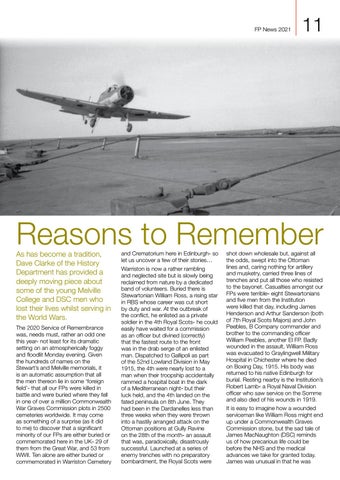FP News 2021
11
Reasons to Remember As has become a tradition, Dave Clarke of the History Department has provided a deeply moving piece about some of the young Melville College and DSC men who lost their lives whilst serving in the World Wars.
The 2020 Service of Remembrance was, needs must, rather an odd one this year- not least for its dramatic setting on an atmospherically foggy and floodlit Monday evening. Given the hundreds of names on the Stewart’s and Melville memorials, it is an automatic assumption that all the men thereon lie in some ‘foreign field’- that all our FPs were killed in battle and were buried where they fell in one of over a million Commonwealth War Graves Commission plots in 2500 cemeteries worldwide. It may come as something of a surprise (as it did to me) to discover that a significant minority of our FPs are either buried or commemorated here in the UK- 29 of them from the Great War, and 53 from WWII. Ten alone are either buried or commemorated in Warriston Cemetery
and Crematorium here in Edinburgh- so let us uncover a few of their stories… Warriston is now a rather rambling and neglected site but is slowly being reclaimed from nature by a dedicated band of volunteers. Buried there is Stewartonian William Ross, a rising star in RBS whose career was cut short by duty and war. At the outbreak of the conflict, he enlisted as a private soldier in the 4th Royal Scots- he could easily have waited for a commission as an officer but divined (correctly) that the fastest route to the front was in the drab serge of an enlisted man. Dispatched to Gallipoli as part of the 52nd Lowland Division in May 1915, the 4th were nearly lost to a man when their troopship accidentally rammed a hospital boat in the dark of a Mediterranean night- but their luck held, and the 4th landed on the fated peninsula on 8th June. They had been in the Dardanelles less than three weeks when they were thrown into a hastily arranged attack on the Ottoman positions at Gully Ravine on the 28th of the month- an assault that was, paradoxically, disastrously successful. Launched at a series of enemy trenches with no preparatory bombardment, the Royal Scots were
shot down wholesale but, against all the odds, swept into the Ottoman lines and, caring nothing for artillery and musketry, carried three lines of trenches and put all those who resisted to the bayonet. Casualties amongst our FPs were terrible- eight Stewartonians and five men from the Institution were killed that day, including James Henderson and Arthur Sanderson (both of 7th Royal Scots Majors) and John Peebles, B Company commander and brother to the commanding officer William Peebles, another EI FP. Badly wounded in the assault, William Ross was evacuated to Graylingwell Military Hospital in Chichester where he died on Boxing Day, 1915. His body was returned to his native Edinburgh for burial. Resting nearby is the Institution’s Robert Lamb- a Royal Naval Division officer who saw service on the Somme and also died of his wounds in 1919. It is easy to imagine how a wounded serviceman like William Ross might end up under a Commonwealth Graves Commission stone, but the sad tale of James MacNaughton (DSC) reminds us of how precarious life could be before the NHS and the medical advances we take for granted today. James was unusual in that he was


















